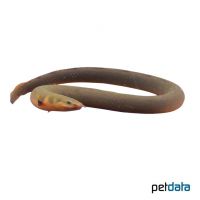Ropefish (Erpetoichthys calabaricus)
| Ropefish Erpetoichthys calabaricus | |
|---|---|
| Name | Ropefish |
| Name Lat. | Erpetoichthys calabaricus |
| Synonym | Calamoichthys calabaricus |
| Family | Bichirs |
| Family lat. | Polypteridae |
| Order | Bichirs |
| Order lat. | Polypteriformes |
| Origin | Africa |
| Habitat | Rivers, lakes |
| Diet | Carnivore |
| pH | 6.0-7.0 |
| Behavior | Predatory |
| Keeping | Pair, group |
| Care Level | Difficult |
| Reproduction | Egg scatterer |
| Breeding | None reported |
| Life Span | 20-25 years |
| Protection | No |
| Metric Units | |
| Size | 40 cm |
| Temperature | 25-28 °C |
| Hardness | 5-15 °dH |
| Aquarium | 150 cm / 370 l |
| US Units | |
| Size | 16" |
| Temperature | 77-82 °F |
| Hardness | 89-267 ppm |
| Aquarium | 100 gal |
Distribution and habitat
The raft eels are widespread in West Africa, from Benin, Nigeria, Cameroon, Equatorial Guinea and the Congo to Angola. They are especially common in the Niger Delta. They are crepuscular and nocturnal predators and like to stay in weedy shore waters with numerous hiding places.
Maintenance
The aquarium should have dense planting, with plenty of hiding and retreat opportunities (roots, stones, caves). A soft substrate, slightly acidic water and subdued light (floating plant cover) is ideal. Due to their way of life they need only little swimming space.
No ammonia, ammonium and nitrite should be detectable, the nitrate value should not exceed 100 mg/l. To ensure the water quality and oxygen content, a filter and heater adapted to the aquarium size is required, as well as lighting for the species-appropriate day-night rhythm of the animals.
Diet
The food supply consists of live food, such as tubifex, black mosquito larvae, shrimps, earthworms, meal beetle larvae and crayfish, which is also accepted in frozen form, supplemented with commercially available frozen special food mixtures. Rarely, high-quality protein-rich dry food (pellets) is also accepted. Due to their visual impairment, food is found with the sense of smell.
A regular and varied diet promotes health and increases resistance. Only as much should be fed as is eaten overnight.
Behaviour and compatibility
They are quite peaceful among themselves. Socialization with cichlids and tetras of suitable size is possible if the tank is set up appropriately. Fish that are too small are considered food.
Basically, only mutually compatible fish species with similar demands on water condition and water temperature may be socialized.
Sex dimorphism
The male has 12-14 rays in the anal fin, the female has only 9 rays
Reproduction and breeding
There are no known reports of successful breeding in the aquarium.
Important
Their swim bladder is divided into two parts, with the larger right part serving as an additional respiratory organ. This allows them to survive for some time out of the water in humid environments. They have to go to the water surface at intervals to breathe atmospheric air, as their gill breathing is not sufficient. If they are prevented from doing so, they suffocate
Care should be taken to provide good aquarium cover (spring protection), as there is a risk of escape, especially during the nocturnal periods of activity. They may lean on their ventrals to rest.
The well-being of the fish should be checked regularly. Temperature should be checked daily, pH, hardness and nitrate levels should be checked at least every 14 days. Regular partial water changes are recommended, even if the contaminant level has not yet reached the upper limit. Sudden changes in water quality should be avoided. Newly introduced fish must be accustomed slowly to the water in the aquarium.
Further literature can be found in your pet store.
References
Text: petdata; Image: petdata
Source: BMELV (1998): Tierschutzgutachten - Haltung von Zierfischen (Süßwasser); RIEHL & BAENSCH (2006): Aquarien Atlas Bd. 1, Mergus Verlag; ENGELMANN (2005): Zootierhaltung - Tiere in menschlicher Obhut: Fische, Verlag Harri Deutsch
- Gemäß § 21 Abs. 5 Tierschutzgesetz idgF
